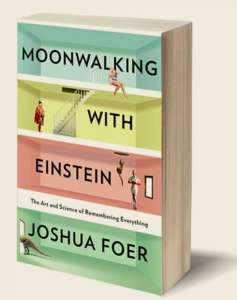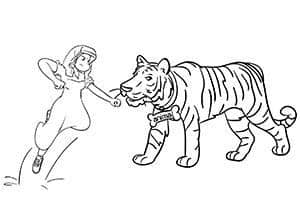Podcast: Download
Subscribe: Apple Podcasts | RSS

You then apply these evocative mnemonic images to help with recalling the important numbers in your life. Such as:
- Phone numbers
- PIN numbers
- Account numbers
- Birthdays
- Math formulas
- Historical dates
- The digits of pi
- Playing cards during games
Technically, the Major System is a phonetic peg system. It works either on its own or in combination with other mnemonic peg systems.
It looks like this, a simple pairing of 0-9 with a specific set of consonants:

Like other mnemonic devices, this means that the Major uses consonant sounds to ‘peg’ numbers to words and images, making them easier to store and retrieve from memory.
Although people have been using the Major System (sometimes called the Major Method) to commit numbers to memory for centuries, there’s a rarely taught, but incredibly powerful dimension you’re about to discover.
I call it “bi-directionality.”
It’s the very approach to the Major System that helped me get my PhD in Humanities at York University. I memorized key historical dates, facts related to the history of science, logical formulas and more.
I’ve also applied the bi-directional Major System to learning several languages. I even used it in 2015 to take second place in a memory competition against a two-time Guinness World Record holder for playing cards.
On this page, I’ll share exactly how to use this mnemonic system yourself for memorizing any number. And I’ll share use cases for how you can get started using the Major System to absorb many other types of information.
Ready to get started applying this system to everything from banking numbers to complex academic material?
Let’s dive in!
What Is The Major System?
The mnemonic Major System dates back more than 2000 years. The earliest version I’ve found is called the katapayadi. You can also find information about the ancient Hebrew version in Eran Katz’s Where Did Noah Park the Ark?
These versions show that people across many cultures have turned to this kind of mnemonic device throughout time.
In our era, it used for everything from credit card numbers and phone numbers to thousands of digits of pi.
Extraordinary as that sounds, Akira Haraguchi famously used the Japanese version of the Major System to recite over 100,000 digits of pi from memory.
A Brief History of the Major System
Historically, we know from Hugh of St. Victor that students of the Bible used a similar system to memorize the dates of Adam and his descendants.
Hugh even linked numbers to people, actions and objects back in the twelfth century in The Three Best Memory Aids for Learning History. You can find an English version of this text in The Medieval Craft of Memory.
Although Hugh was already quite sophisticated, the Major System really start to take shape in the 16th and 17th centuries through people like Giordano Bruno and Robert Fludd.
Both of these Renaissance memory masters used letters and consonants to represent numbers, but their systems were often inconsistent and lacked a standardized approach. Nonetheless, their contributions added new dimensions, such as Bruno’s influence on the development of the Memory Wheel, and Fludd’s evolution of the number-shape system of Jacobus Publicius.
When it comes to developing the standardized system we now use, these are the most important figures.
Johann Justus Winckelmann
Johann Justus Winckelmann was a German mathematician and mnemonist. He proposed a method where each digit was always associated with the same specific consonants, laying the groundwork for later developments.
Aimé Paris
As a French mathematician and memory expert, Aimé Paris simplified the associations, making the system more user-friendly. His version is nearly identical to the Major System as we know it today.
Major Beniowski and the Naming of the System
The Major System is named after Major Beniowski, the 19th-century linguist, memory expert and author of the strangely titled, The Anti-Absurd or Phrenotypic English Pronouncing and Orthographical Dictionary.
Here’s how he graphically represented the Major System in his book by embedding the consonants into each of the digits, 0-9:
Apart from his book, not much is known about Beniowski. Some people believe that “Major” refers to Beniowski’s military rank.
Although that’s the most likely explanation, the name clearly underscores Beniowski’s “major” role in popularizing and standardizing this mnemonic method. Through his teachings and writings, Beniowski helped spread the use of the system, making it accessible to a wider audience.
The name is also much easier to remember than “alpha-numeric” code.
Further Refinement and Popularization
The Major System continues to evolve and gain popularity. Memory experts like Harry Lorayne brought it to the masses. Later books like Moonwalking with Einstein encouraged many people to incorporate the system into their learning lives.
The technique continues to evolve to this day. Many memory competitors now use a variation called the Shadow, which is still based on the same alpha-numeric code you learned earlier in the video above.
If you want to check out some of the most impressive users of the Major, check out my podcast episodes with Katie Kermode and Don Michael Vickers. These memory athletes are seriously impressive.
They’re hardly the first of my memory champion friends to use the method, however.
Using Tony Buzan‘s SEM3 technique, many early memory competitors also used it to win year after year. The Major is still at the core of newer techniques like the Shadow, which competitors like Alex Mullen and Braden Adams have used to stunning effect.
Competition is not something many of us are interested in, however.
And the fact is that the Major System was never just about numbers. Limiting the Major in that ways is one of the biggest limitations learners impose on themselves.
But before we dive into how to use it bi-directionally—for both numbers and deep conceptual memory, let’s make sure you have the fundamentals locked in.
How the Major System Works in English
Now that you know where the Major System comes from, let’s break down exactly how it works. We’ll start by learning the sound-to-number code that makes it so powerful.
You start by converting the digits 0-9 into consonant sounds. This is basically a form of mnemonic chunking, a memory strategy that makes information easier to recall by breaking it down into smaller units.
The smaller these units are, the easier it is to make simple words that can be attached to meaningful associations you won’t forget.
Here’s a table of the core phonetic code used in the English version of the Major System. As you can see, each digit is linked to one or more consonant sounds, which you will eventually use to form words.
As you go through this table, you’ll notice that I’ve added a few suggestions for how to commit these pairings to memory:
- 0 → S or Z (sounds like the “s” in “zero”)
- 1 → T or D (sounds like the “t” or “d” in “toad”)
- 2 → N (has two downstrokes, resembles the letter “n”)
- 3 → M (has three downstrokes, resembles the letter “m” or a moustache on its side)
- 4 → R (the word “four” has four letters and ends in “r”)
- 5 → L (hold your whole hand with the thumb out and the hand makes the “L” shape)
- 6 → J, Sh, Ch, or Soft G (a cursive “j” has a similar shape to “6”)
- 7 → K, G (hard), C (hard), or Q (a “k” can be seen as two mirrored 7s)
- 8 → F or V (cursive “f” and “8” look similar)
- 9 → P or B (both have a loop resembling “9
What About Vowels?
Most people leave all vowels out of the system (A, E, I, O, U) .
That’s because vowels are used to form meaningful words or phrases by inserting them between the consonants.
For example, if you need to memorize 84, you can transform F and R into words like fire and fur. I’ll share a few more examples below to help you get the gist of how vowels work in combination with the consonants.
The Major System in Other Languages
Simon Luisi, a French-Canadian mnemonist and organizer of the Canadian Memory Championship event, uses a variation where 3 is also paired with W and 7 with Y.
To help people expand their Major System, Simon joined me on the Magnetic Memory Method Podcast to discuss his approach in this episode:
In addition to Simon’s variations, you’ll find different versions in many languages.
Languages like Spanish and Russian each adapt the Major System’s consonant assignments to help native speakers of these languages assign the maximum number of words.
Here’s an illustration showing how the Major System looks in Russian. Notice how the logic and its foundations remain, even if the exact consonants change:
In German, the Major System remains identical to English.
However, authors like Ulrich Voigt use the term “Zifferncode.” That’s the term he uses in his excellent book, Esels Welt: Mnemotechnik Zwischen Simonides und Harry Lorayne.
“Ziffern” means digit, and assembling digits into a code of meaning is exactly what you’ll be doing. No matter what language you speak, let’s next explore how to use these digit-sound pairings to make words and expand them into unforgettable mnemonic associations.
How to Turn Numbers Into Vivid Associations with the Major System
The next step is to transform sequences of numbers into vivid mental images.
To remember the number 123, you could break it down like this:
- 1 → T or D
- 2 → N
- 3 → M
From this arrangement, you might form the word “Denim” (D-N-M). This word is reached by inserting vowels between the consonants linked to the digits.
As you can see, D-N-M isn’t any more meaningful than 123. But once you insert the vowels to make a word, it’s easy to imagine denim. You can add even more meaning by imagining someone famous wearing denim whose name sounds similar, like James Dean.
Let’s take another example:
If you had to memorize 22, you could insert the vowel U and imagine a nun. If you had a number like 22235, you could imagine a nun attacking an “animal” like a tiger just by adding more vowels to the sequence to form words.
At this point, you’ve gone beyond mere words. You have the basis for building a narrative, which in the world of mnemonics is called the story method.
Back to the Ancients
I mentioned adding James Dean to make “denim” for 123 much more memorable.
This suggestion is based on an idea from Hugh of St. Victor, whom I mentioned above.
Don’t worry if you don’t know many celebrities.
You can also draw upon people from you real life, such as:
- Friends
- Family
- Professionals (lawyers, teachers, doctors, dentists)
- Pastors
- Authors
- Musicians
- Historical figures
Since Hugh’s time, many people have used this more elaborate approach. It is now called a Person Action Object System or PAO System.
You can read my full PAO System tutorial when you’re done learning the Major.
PAO is the system I wish I had been using when I competed against Dave Farrow, the Guinness World Record holder I told you about in the introduction.
But don’t worry if you’re not ready for it yet. Like I said, I still came in second place with just the Major. You can read the full story of that competition here for more detail.
Now let’s take the vivid associations you’ve learned to form and give them a place to call home.
How to Use the Major System in a Memory Palace
The Memory Palace technique is one of the most powerful ways to situate the associations you’ve assigned in long-term memory. It involves selecting a familiar location and identifying a simple path for you to place figures like tiger-fighting nuns and James Dean wearing jeans.
I’m talking about locations like you:
- Home
- School
- Church
- Favorite cafes, restaurants, movie theatres
- Libraries
- Bookshops
- Parks
The key is to develop clear mental journeys through your Memory Palaces.
They should be truly based on what is in your memory and have little or no imaginary elements (at least not in the beginning). That way your focus can fall on encoding the number-consonant associations into these spaces.
Once you’re set up, convert the numbers you need to memorize into consonants. Then form words or phrases by adding vowels or other non-consonant sounds. These words should be vivid and memorable and follow the principles you can learn by using these visualization exercises.
Next, place the words you come up with in a Memory Palace. Basically, you’re associating each word as a mnemonic image with the location.
Make each one as vivid as possible, with lots of detailed and interactivity.
Here are some examples:
Example 1: 314
3 → M
1 → T or D
4 → R
Word: “Meter”
Memory Palace Placement: Imagine a large meter on the wall of your bedroom.
Example 2: 72
7 → K or G
2 → N
Word: “Gun”
Memory Palace Placement: Picture a gunman standing in the kitchen, guarding the fridge.
By placing these images in specific locations within your Memory Palace, you can mentally walk through the space and easily recall the numbers associated with each image.
How to Get Numbers Into Long Term Memory
This next step is very important.
Although you will increase your ability to memorize this information greatly by not only creating a crazy image and sticking it in a Memory Palace, you can and should lock it down for the long haul.
You do this by revisiting the imagery several times. I suggest you specifically use a process called spaced repetition.
It’s really easy. You’ve created a Memory Palace and you know exactly where to look for that tiger-attacking nun 22235.
And if you’ve got ten pieces of information along that journey, it’s easy to travel it and decode each image. It’s almost like watching a movie.
I recommend that you revisit that journey and watch that movie you’ve created (making sure to decode the imagery and practice retrieving the information) at least 5 times the first day. This suggestion is based on remarks by Dominic O’Brien who created an alternative number mnemonic system called The Dominic System.
What To Do If You Have An Exam Coming Up
If you’re studying for an exam that involves historical dates or formulas, I’d recall the numbers five times a day for a week and then at least 1-2 times a week thereafter. Do this for as long as you want to keep the imagery fresh and available.
It will probably still be there if you don’t perform this Magnetic Memory Method Recall Rehearsal, but you might have to fish around for it.
But if you’re serious about being able to recall the information, you’ll revisit it more than a few times to get it down cold.
That’s just how the method of loci works best. Every good Memory Palace book stresses the same point.
And the best part is that you’ve done so without having to use index cards or any weird and boring stuff like that.
The only time that it’s good to repeat information over and over again is when you’re using your imagination to do it. That makes both your memory and your imaginative abilities stronger and stronger.
Intermediate & Advanced Major System Techniques For Memorizing Numbers
Once you have the basics of the Major Method down, you might want to learn how to create a Person Action Object (PAO) or 00-99 system. For that, please check out The 3 Most Powerful Techniques For Memorizing Numbers.
These next-level techniques for memorizing numbers will then help you in other areas, such as human anatomy. Learning numbers related to blood flow through the heart, for example, are easier and faster to absorb when using the Major System.
You can also think about using a Major System to help you memorize any book. All you need to do is call upon words or images for each page based on the page number.
For example, if you want to memorize a fact on page 75 of a book, you use an image built from the Major System to remember the location in the book. Then you use the page as the Memory Palace.
I did exactly this when I wanted to recall a point about episodic memory in Maps of Meaning. I turned 75 into John Cale and had him interacting with Freud and Shakespeare, who are related to memory science related to how we remember ancient wisdom.
You can also easily use the Major System in combination with a Memory Palace for language learning. I normally use alphabetical associations, but when I can’t think of images for some words, I just think through the consonants as numbers in the Major System and then start using that image.
Even if it’s not perfect or doesn’t exactly reflect pronunciation, it’s at least a starting point.
As a recent example, I did this with a Sanskrit phrase.
Although I later realized that a celebrity I’m aware of was better than my image for 07 (Oliver Sacks), at least working with Sacks to get started with “suktikarajatam” led me to think about using Sook-Yin Lee.
For more on just how deep into history this numerical bi-directionality goes, see my video tutoris called Aristotle’s Nuclear Alphabet and The Imaginary Memory Palace Method of Hugh of St. Victor.
And just to make sure you fully understand how valuable bi-directionality goes, let’s dig deeper into this powerful dimension of the technique.
Bi-Directionality Case Study:
The Hidden Superpower of the Major System
Although it’s perfectly valid to use the Major System only for memorizing numbers like PINs, historical dates and long sequences of digits, you now know there’s more to the technique than that.
As artificial intelligence ramps up, I find myself using it much more often than ever before.
Take Lindy’s Law, for example, a principle which states that the longer something exists, the more likely it will continue to exist.
To lock in that idea using the Major System, I used the number 51 because of the strong L and D in “Lindy.”
Here’s a quick YouTube short to enhance the written explanation that follows:
As you can see, I turned L and D into a name more familiar to me than Lindy: Alan Ladd. (L = 5 and D = 1).
I then imagined Alan Ladd pouring a “latte” (also 51) over a copy of Shane, his most-known film. Since this movie has endured for generations, it’s very likely it will continue to enjoy fame.
This is the power of using the Major System in a bi-directional way.
Rather than limiting yourself to using the Major System for numbers, you’re using it to encode words and concepts using the same system.
You’ve now doubled its value, if not more as you start using it to mentally catalog entire books, vocabulary lists and more with greater speed and accuracy.
Major System FAQ
As you’ve seen, the Major System is a powerful mnemonic technique that converts numbers into consonants.
By inserting vowels, you can create simple words that can be expanded into vibrant images and stories.
Let’s turn now to some of the questions I’ve received about it over the years with some answers that will help expand what you’ve just learned.
Why should I use the Major System?
Numbers are abstract and difficult to remember.
But by turning digits into images and stories, your brain remembers them.
As you’ve seen, you can also use the Major System bi-directionally. Whenever you struggle to find an association for a word or concept using the alphabetical pegword method, you can look at the numbers associated with the consonants. Then use those images.
Personally, I wish I would have started using the bi-directional approach much sooner.
Is the Major still worth learning in the age of AI?
Absolutely yes.
As you saw in the YouTube short above, I recently used it to memorize an important concept in computer science.
So if anything, it’s even more valuable now than in any other period of history.
Remember, the value of thinking in relationships, associations and patterns is beyond measure. You differentiate yourself by mastering this mnemonic system.
What’s the difference between the Major System and the Dominic System?
The Dominic System assigns numbers to people specifically using their initials.
For example, 1 = Andre the Giant, 2 = Bugs Bunny, 3 = Cheshire Cat.
Although the Dominic System is just as structured in its way, there’s a higher level of arbitrariness. You have to work harder to make the link between the associations.
The Major is much more flexible and less arbitrary. There’s a reason why you use the pope for 99 (because 9 is associated with B or P). You’re getting more value because of how easy it is to make words and logically infer why you chose them.
What about the Shadow System?
Although based on the Major, I believe the Shadow is specifically for memory competition.
In my understanding, it evolved for card memorization because competitors want to memorize multiple decks at a time. This means you will get two Jack of Hearts in row (if not more).
It’s definitely worth looking into, but I stopped learning it when I realized I would never use it.
What if I forget which vowel I inserted between the consonants?
This might happen in the beginning.
But as you establish a standard set of words for all of the 2-digit pairs, you’ll use the same associations repeatedly.
When I drilled mine to memory the first time, I put all the numbers from 00-99 on index cards. I then practiced shuffling them and naming my chosen figures.
Once I could name them all within seconds, I started practicing memorizing strings of digits.
By the time I had realized that the Major could be used bi-directionally, I was able to easily apply the same images to vocabulary and phrases.
How can I practice applying the Major System for real world benefit?
There are a number of valuable ways to practice applying the Major System once you’ve learned it. You can:
- Take memory number tests frequently.
- Keep a journal as suggested by accomplished memory athlete Johannes Mallow.
- Put numbers on flashcards and test yourself manually.
- Use the International Association of Memory’s free software for generating random numbers.
- Attach the Major System to a pack of playing cards and memorize their order.
- Study vocabulary by using the bi-directional method.
How often should I practice?
It’s really up to you and your needs.
But as I discuss in my book on how to memorize numbers, math and equations, I usually practice 3-4 times a week, typically by using the final method: playing cards.
But all of the above methods are a lot of fun and I use the technique as I read often as a kind of “Magnetic Bookmark.”
Rather than putting a print bookmark into my books, I glance at the page number and have my association interact with the information on the page. That makes it easy to remember where I was in the book.
Can I use the Major System for memorizing formulas?
Yes, and the technique applies to formulas in multiple areas, from chemistry to physics, biology to computer science and programming. You can also apply the Major to speed math and becoming a mental calculator.
Here’s a video where I break down how to do exactly that:
The trick is always to make sure that you are prepared with the additional symbol and alphabet systems I describe in the video above.
To give you a quick example:
When I was learning the formulas used in logic, I imagined a totem pole for totality and an air conditioner blowing cold air on one of the Ninja Turtle’s weapons for condition. These are examples of the pegword method applied to visual symbols.
For even more advanced techniques related to numbers and equations with examples, please go through my detailed tutorial on how to memorize a textbook.
What’s the role of chunking in the Major System?
The reason systems like the Major work so well is that they help you break long strings of information down into manageable units.
People who memorize large amounts of pi aren’t really memorizing dozens of digits at a time. They are memorizing how interesting images interact in their Memory Palaces.
By recalling these compelling scenarios, they “translate” them back into the original digits.
Should I apply the Magnetic Memory Method technique of KAVE COGS to the Major System?
Yes. Doing so will make your associations even stickier in your Memory Palaces.
In case you’re new to KAVE COGS, it is an acronym to help you remember to add the following multi-sensory associations:
- Kinesthetic
- Auditory
- Visual
- Emotional
- Conceptual
- Olfactory
- Gustatory
- Spatial
With “denim” for 123, you might feel what it’s like to be James Dean wearing denim and hear the zipper as you imagine looking at them.
You can smell the denim and imagine its size and really make things strange by tasting it and adding a zany concept. For example, James Dean could be trying to fit jeans over his race car, using the concept of racing to make the word denim more memorable.
What if the number-consonants don’t form words I like or want to use?
This problem is common.
And the answer is practice without thinking too much about whether one likes or dislikes the possible word options.
For example, even if I don’t care much for Thomas Szasz, but he’s a great image for 00.
In my mind, he’s more concrete than Zeus. Although Zeus is an option, there are countless pictures of this Greek god.
But Thomas Szasz is unique and that’s why I tend to use him the most.
Of course, you also have the option of more than one figure or association. That’s where the PAO System comes in because it gives you three different options.
Can kids or beginners learn the Major System?
Absolutely.
But if you or your children find it too challenging, ease your way in using number rhymes.
Here’s my full tutorial on rhymes for memorizing numbers.
How do I avoid getting confused when the same digits appear twice in a Memory Palace (i.e. 33 or 44)?
This is where the Memory Palace technique really shines.
Because any duplicate numbers appear in their own spot along the Memory Palace journey, it’s difficult to get them confused.
33 on your living room recliner is not the same as the 33 in your sink.
When you add KAVE COGS in a way that includes the recliner and the sink, both the associations and the locations become even more unique.
And make sure to sign up for my free memory course here:
It gives you free worksheets and videos that walk you through getting your Memory Palaces and images created optimally in minimum time. But with maximum effect.
So what do you say?
Are you ready to get out there and master the Major System?
Make it happen!
Related Posts
- Tap The Mind Of A 10-Year Old Memory Palace Master
Alicia Crosby talks to us about how she memorized all of Shakespeare's plays in historical…
- Memory Improvement Techniques For Kids
You're never too young to get started with memory techniques
- The Memory Code: Prehistoric Memory Techniques You Can Use Now
Lynne Kelly, author of The Memory Code, shares her personal experiences learning ancient memory techniques…










4 Responses
One doubt, when we create associations and place them in the memory palace, do we always need to retrieve our crazy multisensory images, or does the target information come to mind when we pass through the stations?
Thanks for this question.
The answer really depends on the extent to which you have appropriately used Recall Rehearsal to establish long-term retention.
My personal goal for memorizing historical dates and other numerical matter when using the Major System is to develop knowledge that comes to mind without having to revisit the Memory Palaces. That’s why I use Recall Rehearsal so deliberately. And I strongly suggest others do the same if they also want to enjoy long-term recall of any information, not just numerical data.
I am now in my third year as a student of The Magnetic Memory Method Mater Program.
I strive to utilize these methods daily in day to day affairs, for me now retired. The entire system has facilitated me challenging myself to go further to retain more information longer
This entire approach helps me in tandem with my medical treatments for having incurred much head trauma in my 71 years on this planet. I aways wait with anticipation for what Dr. Anthony has for us all next.
I state these comments with much appreciation.
Grandpa Bill
Anthony,
Thank you for an informative and comprehensive deep-dive into the history and practice of mnemonics.